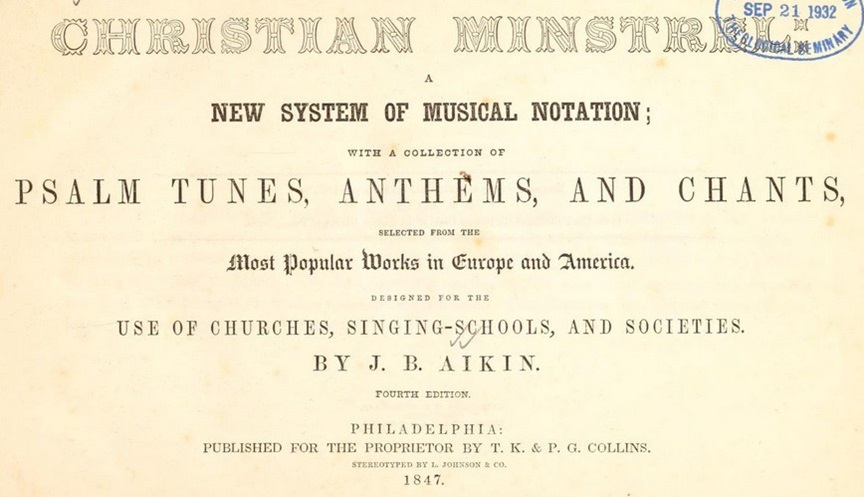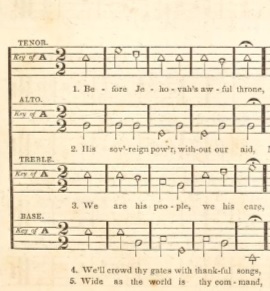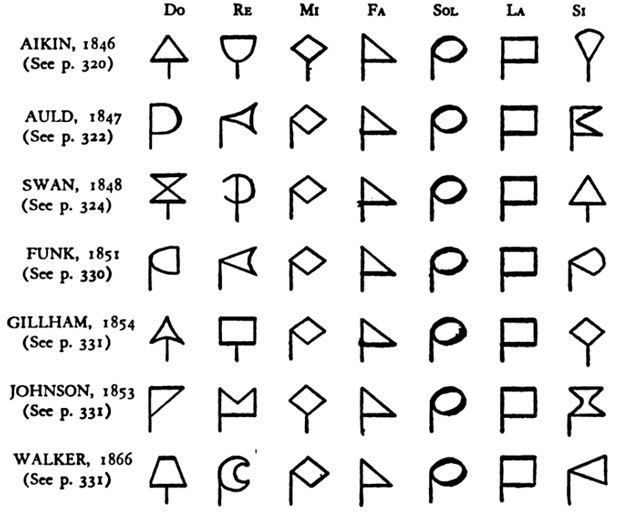


Christian Minstrel: A New System of Musical Notation; with a collection of Psalm Tunes, Anthems, and Chants, selected from the Most Popular Works in Europe and America Designed for the Use of Churches, Singing-Schools, and Societies was published in 1846 by Jesse Bowman Aikin (1808--1900). Aikin found the old music system to be "very erroneous in five particulars." He made some innovative changes using a completely new system for music to fix these errors as he saw them.
He placed G on the third line of each staff, as opposed to the third line as B in the staff that uses the treble clef and D in the staff that uses the bass clef. This was to bring uniformity to the lettering of the staves. For anyone learning how to read music, the student needs to learn is just one staff. With this new system the bass or treble clefs are not needed.
Aikin's system does not require a separate labeling of songs written in a minor key rather than those of a major key. Aikin felt that there was no practical purpose to make two separate scales, or two separate keys, out of one. Therefore the "imaginary minor key" forms no part in this new system. "Consequently, the music student, having mastered the seven scales founded upon the seven letters occupying their seven fixed places on the staff, will find his mind no longer confused and his memory burdened with endless distinctions."
Aikin found the use of sharps and flats in the key signature too complicated for music students to learn. On the line or space where "Do" was placed, it was worded as to what key the music would use. If the song was supposed to be sung in the key of C, or even in A minor, then in the key signature area of the staff it would be written on the C line "Key of C."
Aikin thought that nine varieties of measure, or moods of time were too many and too redundant. To him, 2/2 time was not faster or slower than 2/4, and 3/2 and 3/8 were practically the same. Every song in the Christian Minstrel is either written in 2/2 time for even time, or 3/2 for uneven time. Aikin's new system "prevents all evil and accomplishes every purpose that can be needed or desired."
Aikin's final correction was the use of a seven-syllable scale, as opposed to the four-syllable scale. He thought the seven-syllable system was superior. With these three added syllables, Aikin added three more shapes. He kept the four shapes from William Little and William Smith's The Easy Instructor, and he added a house-top triangle for "Do," a half-circle for "Re," and cone for "Si." (A few years later, some traditions later changed "Si" to "Ti.") Of all of Aiken's musical innovations, this is the only change that would endure.
In the 30 years that followed, Aikin would be very protective of his shape-note system. He would often make threats of a lawsuit to those who wanted to publish tune books using his shapes. To avoid these lawsuits, other tune book compilers would generate their own three shapes for "Do," "Re," and "Si (Ti)" until about 1877 when Aldine Kieffer began to publish tune books using Aikin's shape-note system. Aiken's shapes then became the standard for all other following publications to use.

Sources:
Aikin, Jesse B. The Christian Minstrel: A New System of Musical Notation; with a collection of Psalm Tunes, Anthems, and Chants, selected from the Most Popular Works in Europe and America Designed for the Use of Churches, Singing-Schools, and Societies. (Philadelphia: Published for the proprietor by T. K. & P. G. Collins, 1846).
Britton, Allen P. "The Original Shape-Note Tune Books." Studies in the History of American Education. Claude Eggertsen. (Ann Arbor: School of Education, University of Michigan, 1947).
Hatchett, Marion J. A Companion to 'The New Harp of Columbia'. Knoxville: The University of Tennessee Press, 2005).
McLemore, B. F. Tracing the Roots of Southern Gospel Singers. ([Jasper, Tex.]: B. F. (Bob) McLemore, 2005).